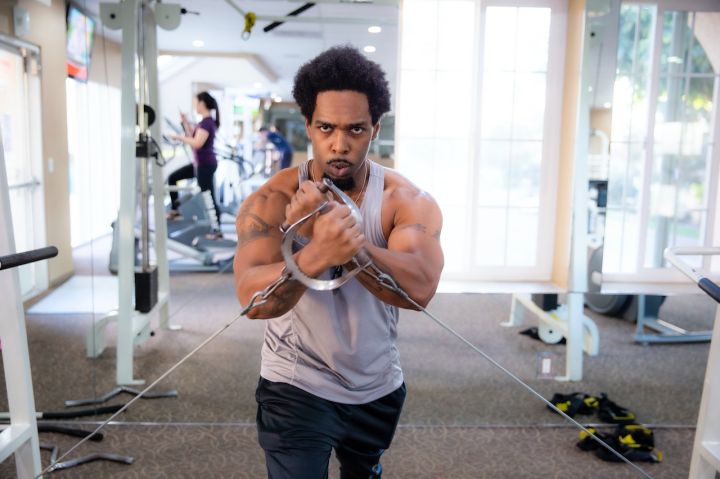4 Shoulder Training Moves To Thicken Your Deltoids And Successfully Train Broad Shoulders
A broad shoulder is very much related to the movements you do. The more complex the shoulder training movements are, the more strength you need in your shoulders and the less weight you will carry in your shoulders. Some fitness enthusiasts choose high difficulty shoulder training movements, but the results are not very good and the shoulders will be hard to bear because those difficult shoulder training movements will make you have better upper body coordination, but rarely improve the shoulder circumference.

Dumbbells are normally hard to practice, more so than push-ups, but they are more effective at raising shoulder circumference than push-ups. The other shoulder exercises such as the inverted push-up and the push press can be a little difficult to practice and are not very effective in raising the deltoids.

Here are 4 moves to share with you from your own personal experience, stick to them, it's not a problem to train broad shoulders, let's take a look.
I. Rope lifting
We all know that pulling is the most dangerous action in shoulder training, it is easy to cause shoulder sprain or shoulder impact when doing this action, which can easily cause unnecessary accidents in exercise.
The rope lift can effectively reduce the injury to the shoulder, because it is a rope, our elbow joint will be more mobile, the possibility of shoulder sprain or shoulder impact will be greatly reduced, which is also very good for health.

The rope lift is suitable for gym goers who are initially training their deltoids, as the rope lift is a high weighted, highly stimulating and precise movement that can effectively stimulate the muscles.
During the exercise, we pull the rope up to the chest or chin position, but it is important to note that pulling the rope up to the chin position can cause a risk of shoulder impingement. Also, keep deliberately sinking when performing this movement, otherwise it is prone to sprains and has a low safety margin, so it is not recommended for students who are just starting to exercise with this method.

Two, smith push-ups
Smith push-up is the movement that goes to the strongest ability in china. Generally speaking, in carrying out the smith push-up movement, because the trajectory is fixed, the shoulder does not have to divide a lot of strength to stabilize the lever, so that the negative weight will increase, but also can greatly improve the accuracy of shoulder training, the effect is still very obvious in the process of exercise.

With the smith press, it is worth noting that we need to ensure that we sink the shoulders, i.e. Sink the shoulder blades as far as possible, and try not to shrug the shoulders or retract the head, as shrugging or retracting the head will cause the trapezius and back muscles to borrow force, leading to a significant decrease in the effectiveness of shoulder training.

When performing the smith push-up, do slightly shorten the grip distance between your hands so that the shoulders feel more squeezed during the overhead press.
Iii. Seated dumbbell push-ups
Dumbbell push-ups with a large amplitude can increase the range of motion of the deltoid muscle and stimulate the deltoid muscle, this action is emulated by most people, born when we have to know that are training, just go to do so a movement, make a variety of looks, this will only increase fatigue, but also dissolved oxygen instrument cause muscle tear.

Seated dumbbell push-ups are a movement that many people choose to practice their deltoids. When you feel that the effect of this movement is not very obvious, it means that it is not the movement that is not in place, but the number of times you do it is not enough.

The dumbbell push-up movement is similar to the lever press movement, but when doing this movement, people may involuntarily tilt their small arms, or lean back, and cause them to maintain a vertical angle to the ground. When doing this movement, keep the dumbbells moving in a straight line from the position of the ears, pay attention to the small arms not to lean forward, pay more attention in the usual training and train consciously, so that we can make our shoulder effect more precise and ensure safety during the movement.
Four: Rope face pull
The rope face pull is a movement that has the best weight-bearing capacity in the posterior deltoid training movement, and it is suitable for bombing the circumference of the posterior deltoid muscle bundle. This is one of the most powerful exercises for the posterior deltoid muscle bundle.
There are two ways to do this movement, the first being to train the posterior fascia in a standing position, which has the disadvantage of having a low weight capacity and is not particularly effective. The other way is to step on a chair with one foot and use it as a stirrups, so that you can do a rope pull.

There is a technique to practice rope face pull, that is, in the grip method need to pay attention to, take the thumb to the equipment way to grip, this can effectively reduce the sudden situation.
Also using an internal rotation of the palms to perform the movement allows for precise stimulation of the posterior shoulder muscles, while effectively enhancing the stimulation of the posterior shoulder girdle.

The movements here are recommended to be done seven to eight times per group, with one to achieve fitness purposes. The exercise of these movements requires a certain amount of time to accumulate, and can be tried continuously after two or three months of fitness, while compared to other movements that can be postponed, the above is a specific approach to developing broad shoulders.
